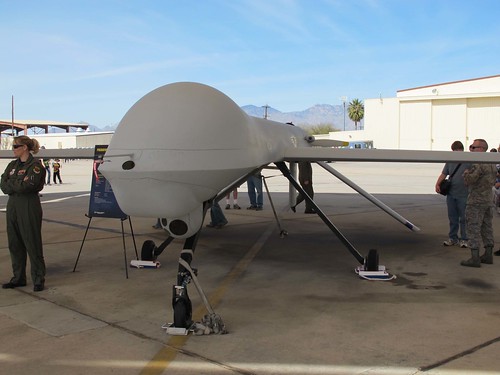
Successive US administrations have regarded unmanned aerial vehicles (UAVs) as among the most effective tools for fighting the ‘war on terror’. John Brennan – Barak Obama’s pick for the next director of the Central Intelligence Agency (CIA) – has stated that UAVs are surgically precise weapons that allow the United States to undertake the ‘targeted killing’ of terrorists. Collateral damage, in terms of the lives of civilians and pilots, is minimized, with UAVs also thought to be cheaper to purchase per unit than fighter aircraft. If so, then UAVs may eventually replace aircraft as the mainstay of the United States’ Air Force.
UAVs have, therefore, become an essential feature of the United States’ vision of lighter and more technologically advanced armed forces capable of conducting light-footprint warfare. This places far less emphasis on fighting land wars and more on the use of UAVs, special-forces, private contractors and local partners to target a diffused and dispersed network of enemies. As part of its commitment to light-footprint warfare, Washington has been working to establish a network of small airbases in Africa to track extremist groups like al Qaeda in the Islamic Maghreb (AQIM) and Al Shabaab, and hunt down alleged war criminals like Jospeh Kony.
However, not everyone is convinced that UAVs are cheaper and more effective than traditional reconnaissance and counter-terrorism activities. Winslow Wheeler, for example, argues that ‘we are getting little, but paying a lot’ for the deployment of UAVs over Afghanistan. A recent report by the American Security Project has also found that UAVs are only slightly cheaper to acquire and operate than conventional fighter jets. Unmanned missions are also labor-intensive: they require an average flight crew of at least two – a pilot and a sensor operator – and possibly up to 130 additional personnel to operate sensors, ground control and satellite links.
Michael Boyle, Barack Obama’s former security advisor, has also argued that UAVs may endanger Washington’s strategy of transformational diplomacy and the encouragement of ‘democratic, well-governed states’. Instead, UAVs may ‘encourage, a new arms race that will empower current and future rivals and lay the foundation for an international system that is increasingly violent’. To support such arguments, Boyle might point to the fact that Iran now claims that it has an armed UAV as well as China’s and Japan’s increasing interest in the use of unmanned technology to support their respective territorial claims in the East China Sea.
Concerns also remain that unmanned airstrikes continue to impact upon the security of civilians. Research conducted by New York and Stanford Universities suggests that the United States’ unmanned campaigns cause ‘considerable and under-accounted harm to the daily lives of ordinary civilians’ and increased anxiety in areas where UAVs operate. And while unmanned airstrikes have helped to disrupt terrorist networks and armed groups, it is also estimated that high-level targets account for just 2% of the total casualties of unmanned airstrikes.
It has also been argued that UAVs may, in fact, complicate Washington’s counter-terrorism strategies. A recent New York Times report claims that “drones have replaced Guantánamo as the recruiting tool of choice for militants.” The report also suggests that UAVs have undermined US-Pakistani relations and Washington’s reputation within the international system. Critics also claim that the use of UAVs for targeted killings undermines respect for the rule of law. Indeed, the United States’ covert activities over Pakistan may even contradict Washington’s commitment to subjecting unmanned activities to democratic oversight.
Consequently, if the United States wants to restore its reputation on the international stage, Washington might need to develop appropriate legal frameworks to support its unmanned aerial campaigns. It may also be necessary for the United States to reassess the effectiveness and efficiency of its UAV activities around the world. In doing so, Washington may have to look beyond costs per unit and take into account that civilians are among the casualties caused by unmanned airstrikes.
For more information on issues and events that shape our world please visit the ISN’s featured editorial content and Security Watch.

